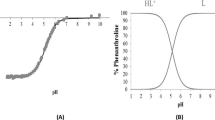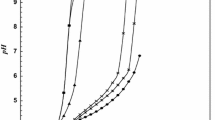Abstract
Binary and ternary complex formation equilibria of copper(II) with imidazole-4-acetic acid (IMA) and some aromatic amino acids such as tryptophan and phenylalanine have been studied from 15 to 45 °C by potentiometric titration. The pH-titrations of the reaction mixtures have shown 1:1:1 (Cu:IMA:amino acid) ternary complex formation. The stability of mixed-ligand complexes was quantitatively compared with the stability of the binary complexes as Δlog10 K, Δlog10 β and log10 X parameters. The speciation of different species in solution has been evaluated as a function of pH. The effect of temperature on protonation of the ligands and formation of mixed ligand complexes was investigated. Thermodynamic parameters were calculated and are discussed. The effect of solvent of the protonation of IMA and Cu–IMA complex formation was also investigated and discussed. Additionally, the stoichiometric protonation constants (log10 β) of imidazole-4-acetic acid and its binary Cu(II)–IMA complexes were determined potentiometrically over a wide range of solvent composition.







Similar content being viewed by others
Abbreviations
- IMA:
-
Imidazole-4-acetic acid
- Phe:
-
Phenylalanine amino acid
- Trp:
-
Tryptophan amino acid
References
Sigel, A., Sigel, H., Sigel, R.K.O. (eds.): Metal Ions in Life Sciences, vol. 1. Wiley, Chichester (2006)
May, P.M., Williams, D.R.: In: Sigel, H. (ed.) Metal Ions in Biological Systems Properties of Copper, vol. 12. Marcel Dekker, New York (1981)
Sigel, H. (ed.): Metal Ions in Biological Systems, vol. 13. Marcel Dekker, New York (1981)
Miura, T., Hori-J, A., Mototani, H., Takeuchi, H.: Raman spectroscopic study on the copper(II) binding mode of prion octapeptide and its pH dependence. Biochemistry 38, 11560–11569 (1999)
Solomon, E.I., Szilagyi, R.K., George, S.D., Basumallick, L.: Electronic structures of metal sites in proteins and models: Contributions to function in blue copper proteins. Chem. Rev. 104, 419–458 (2009)
Solomon, E.I., Sundaram, U.M., Machonkin, T.E.: Multicopper oxidases and oxygenases. Chem. Rev. 96, 2563–2606 (1996)
Fujimori, T., Yamada, S., Yasui, H., Sakurai, H., In, Y., Ishida, T.: Orally active antioxidative copper(II) aspirinate: synthesis, structure characterization, superoxide scavenging activity, and in vitro and in vivo antioxidative evaluations. J. Biol. Inorg. Chem. 10, 831–841 (2005)
Lobana, T.S., Rekha, R., Butcher, R.J., Castineiras, A., Bermejo, E., Bharatam, P.V.: Novel oxygen chirality induced by asymmetric coordination of an ether oxygen atom to a metal center in a series of sugar-pendant dipicolylamine copper(II) complexes. Inorg. Chem. 45, 1535–1551 (2006)
Belicchi-Ferrari, M., Bisceglie, F., Pelosi, G., Sassi, M., Tarasconi, P., Dornia, M., Capacchi, S., Albertini, R., Pinelli, S.: Synthesis, characterization and X-ray structures of new antiproliferative and proapoptotic natural aldehyde thiosemicarbazones and their nickel(II) and copper(II) complexes. J. Inorg. Biochem. 90, 113–126 (2002)
Remko, M., Fitz, D., Broer, R., Rode, B.M.: Effect of metal ions (Ni2+, Cu2+ and Zn2+) and water coordination on the structure of l-phenylalanine, l-tyrosine, l-tryptophan and their zwitter ionic forms. J. Mol. Model. 17, 3117–3128 (2011)
Bell, C., Abrams, J., Nutt, D.: Tryptophan depletion and its implications for psychiatry. Br. J. Psychiatry 178, 399–405 (2001)
Markus, C.R., Olivier, B., De Haan, E.H.F.: Whey protein rich in α-lactalbumin increases the ratio of plasma tryptophan to the sum of the other large neutral amino acids and improves cognitive performance in stress-vulnerable subjects. Am. J. Clin. Nutr. 75, 1051–1056 (2002)
Frausto da Silva, J.J.R., Williams, R.J.P.: The Biological Chemistry of the Elements; The Inorganic Chemistry of the Life. Clarendon Press, Oxford (1991)
Bertini, I., Gray, H.B., Lippard, S.J., Valentine, J.S.: Bioinorganic Chemistry. University Science Books, Mill Valley (1994)
Gilman, A.G., Goodman, L.S.: Goodman and Gilman’s the Pharmacological Basis of Therapeutics, 10th edn. Mc-Graw Hill, New Jersey (2002)
Kimura, E., Kurogi, Y., Shionoya, M., Shira, M.: Synthesis, properties, and complexation of a new imidazole-pendant macrocyclic 12-membered triamine ligand. Inorg. Chem. 30, 4524–4529 (1991)
Schayer, R.W.: The metabolism of ring labeled histamine. J. Biol. Chem. 196, 469–475 (1952)
Baldridge, R.C., Tourtellotte, C.D.: The metabolism of histidine. III. Urinary metabolites. J. Biol. Chem. 233, 125–127 (1958)
Khandelwal, J.K., Prell, G.D., Morrishow, A.M., Green, J.P.: Presence and measurement of imidazoleacetic acid, a γ-aminobutyric acid agonist, in rat brain and human cerebrospinal fluid. J. Neurochem. 52, 1107–1113 (1989)
García-Raso, A., Fiol, J.J., Adrover, B., Tauler, P., Pons, A., Mata, I., Espinosa, E., Molins, E.: Reactivity of copper(II) peptide complexes with bioligands (benzimidazole and creatinine). Polyhedron 22, 3255–3264 (2003)
El-Sherif, A.A.: Shoukry: M.M.: Copper(II) complexes of imino-bis(methyl phosphonic acid) with some bio-revelant ligands. Equilibrium studies and hydrolysis of glycine methyl ester through complex formation. J. Coord. Chem. 58, 1401–1415 (2005)
El-Sherif, A.A.: Coordination chemistry of palladium(II) ternary complexes with relevant biomolecules. In: Stoichiometry and Research (ed.) The Importance of Quantity in Biomedicine, pp. 79–120. In-Tech Publisher, Rijeka (2012)
El-Sherif, A.A.: Mixed ligand complex formation reactions and equilibrium studies of Cu(II) with bidentate heterocyclic alcohol (N, O) and some bio-relevant ligands. J. Solution Chem. 41, 813–824 (2010)
El-Sherif, A.A.: Coordination properties of bidentate (N, O) and tridentate (N, O, O) heterocyclic alcohols with dimethyltin(IV) ion. J. Coord. Chem. 64, 1240–1253 (2011)
El-Sherif, A.A., Shoukry, M.M., Hosny, W.M., Abd Al-Moghny, M.G.: Complex formation equilibria of unusual seven-coordinate Fe(EDTA) complexes with DNA constituents and related bio-relevant ligands. J. Solution Chem. 41, 813–827 (2012)
El-Sherif, A.A.: Mixed-ligand complexes of 2-(aminomethyl)benzimidazole palladium(II) with various biologically relevant ligands. J. Solution Chem. 35, 1287–1301 (2006)
Jeffery, G.H., Bassett, J., Mendham, J., Deney, R.C.: Vogel’s Textbook of Quantitative Chemical Analysis, 5th edn. Longman, London (1989)
Schwarzenbach, G., Flaschka, H.A.: Complexometric Titrations. Barnes and Noble-Methuen, New York (1957)
Gran, G.: Determination of the equivalence point in potentiometric titration. Part II. Analyst 77, 661–671 (1952)
Aljahdali, M.S., El-Sherif, A.A., Hilal, R.H., Abdelkarim, A.T.: Mixed bivalent transition metal complexes of 1,10-phenanthroline and 2-aminomethylthiophenyl-4-bromosalicylaldehyde Schiff base: Spectroscopic, molecular modeling and biological activities. Eur. J. Chem. 4, 370–378 (2013)
Buck, R.P., Rondinini, S., Covington, A.K., Baucke, F.G.K., Brett, C.M.A., Camoes, M.F., Milton, M.J.T., Mussini, T., Naumann, R., Pratt, K.W., Spitzer, P., Wilson, G.S.: Measurement of pH. Definition, standards, and procedures. Pure Appl. Chem. 74, 2169–2200 (2002)
Gündüz, T., Kılıç, E., Köpseoğlu, F., Canel, E.: Protonation constants of some substituted salicylideneanilines in dioxan–water mixtures. Anal. Chim. Acta 282, 489–495 (1993)
Van Uitert, G.L., Hass, C.G.: Studies on the coordination compounds. A method for determining thermodynamic equilibrium constants in mixed solvents. J. Am. Chem. Soc. 75, 451–455 (1971)
Aljahdali, M., Foti, C., El-Sherif, A.A., Mohamed, M.M.A., Soliman, A.A.: Al Ruqi, O.S.: Potentiometric determination of stability constants and thermodynamic data for dimethyltin(IV) dichloride complexes with iminobis(methylphosphonic acid) in water and dioxane–water mixtures. Monatsh. Chem. 144, 1467–1480 (2013)
Kılıç, E., Aslan, N.: Determination of autoprotolysis constants of water–organic solvent mixtures by potentiometry. Microchim. Acta 151, 89–92 (2005)
Woolley, E.M., Hurkot, D.G., Hepler, L.G.: Ionization constants for water in aqueous organic mixtures. J. Phys. Chem. 74, 3908–3913 (1970)
Gans, P., Sabatini, A., Vacca, A.: An improved computer program for the computation of formation constants from potentiometric data. Inorg. Chim. Acta 18, 237–239 (1976)
Pettit, L.: University of Leeds, Personal Communication
HyperChem version 7.5 Hypercube, Inc. (2003)
Soliman, A.A., El-Sherif, A.A., Amin, M.A.: Thermodynamics, chemical speciation and complex formation equilibria studies of binary and mixed ligand complexes of Cu(II) with 2,2’-bipyridyl and some aromatic diamines. J. Solution Chem. 44, 77–99 (2015)
Rayan, A.M., Ahmed, M.M., Barakat, M.H., Abdelkarimd, A.T., El-Sherif, A.A.: Complex formation of cetirizine drug with bivalent transition metal(II) ions in the presence of alanine: synthesis, characterization, equilibrium studies, and biological activity studies. J. Coord. Chem. 68, 678–703 (2015)
Smith, R.M., Martell, A.E.: NIST Standard Reference Database. NIST Critically Selected Stability Constants of Metal Complexes Database. Version 3.0. Data collected and selected by U.S. Department of Commerce, National Institute of Standards and Technology (1997)
Tȍrȍk, I., Surdy, P., Rockenbauer, A., Korecz Jr, L., Anthony, G., Koolhaas, A., Gajda, T.: Nickel(II)-, copper(II)- and zinc(II)-complexes of some substituted imidazole ligands. J. Inorg. Biochem. 71, 7–14 (1998)
Aljahdali, M., El-Sherif, A.A., Shoukry, M.M., Mohamed, S.E.: Potentiometric and thermodynamic studies of binary and ternary transition metal(II) complexes of imidazole-4-acetic acid and some bio-relevant ligands. J. Solution Chem. 42, 1028–1050 (2013)
El-Sherif, A.A.: Potentiometric determination of the stability constants of trimethyltin(iv) chloride complexes with imino-bis(methylphosphonic acid) in water and dioxane–water mixtures. J. Solution Chem. 41, 392–409 (2012)
Mahrouka, M.M., Abdelkarim, A.T., El-Sherif, A.A., Shoukry, M.M.: Potentiometric and thermodynamic studies for binary and mixed ligand complexes of some transition metal ions with hydrazone and phenylalanine. Int. J. Electrochem. Sci. 10, 456–471 (2015)
Phillips, C.S.G., Williams, R.J.P.: Inorganic Chemistry, vol. 2, p. 268. Oxford (1966)
Cotton, F.A., Wilkinson, G.: Advanced Inorganic Chemistry. Wiley, London (1962)
Sigel, H.: Coordination Chemistry, vol. 20. Pergamon Press, Oxford (1980)
Walker, F.A., Sigel, H., McCormick, D.B.: Spectral properties of mixed-ligand copper(II) complexes and their corresponding binary parent complexes. Inorg. Chem. 11, 2756–2763 (1972)
Aljahdali, M.S., El-Sherif, A.A.: Equilibrium studies of binary and mixed-ligand complexes of zinc(II) involving 2-(aminomethyl)-benzimidazole and some bio-relevant ligands. J. Solution Chem. 41, 1759–1776 (2012)
Maggiore, R., Musumeci, S., Rizzarelli, E., Sammartano, S.: Complexes of Cu2+ with 2,2-dipyridyl and cyclohexane-1,1-dicarboxylic acid. Inorg. Chim. Acta 18, 155–158 (1976)
Mahmoud, M.M.A., El-Sherif, A.A.: Complex formation equilibria between zinc(II), nitrilo-tris(methylphosphonic aid) and some bio-relevant ligands. The kinetics and mechanism for zinc(ii) ion promoted hydrolysis of glycine methyl ester. J. Solution Chem. 39, 639–653 (2010)
Kramer-Schnabel, U., Linder, P.W.: Substituent effects in the protonation and complexation with copper(II) ions of organic monophosphate esters. A potentiometric and calorimetric study. Inorg. Chem. 30, 1248–1254 (1991)
Rees, D.C.: Experimental evaluation of the effective dielectric constant of proteins. J. Mol. Biol. 141, 323–326 (1980)
Rogersa, N.K., Mooreb, G.R., Sternberga, M.J.E.: Electrostatic interactions in globular proteins: calculation of the pH dependence of the redox potential of cytochrome C551. J. Mol. Biol. 182, 613–616 (1985)
Åkerlöf, G., Short, O.A.: The dielectric constant of dioxane–water mixtures between 0° and 80°–correction. J. Am. Chem. Soc. 75, 6357–6362 (1953)
Jameson, R.F., Wilson, M.F.: Thermodynamics of the interactions of catechol with transition metals. Part I. Free energy, enthalpy, and entropy changes for the ionisation of catechol at 25°C. Comparison of the temperature-coefficient method with direct calorimetry. J. Chem. Soc., Dalton Trans. 23, 2507–2610 (1972)
Mohamed, M.M.A., Shehata, M.R., Shoukry, M.M.: Trimethyltin(IV) complexes with some selected DNA constituents. J. Coord. Chem. 53, 125–142 (2001)
El-Sherif, A.A.: Mixed ligand complex formation reactions and equilibrium studies of Cu(II) with bidentate heterocyclic alcohol (N, O) and some bio-relevant ligands. J. Solution Chem. 39, 131–150 (2010)
El-Sherif, A.A., Shoukry, M.M., Abd-Elgawad, M.M.A.: Protonation equilibria of some selected α-amino acids in DMSO–water mixture and their Cu(II)-complexes. J. Solution Chem. 42, 412–427 (2013)
Doğan, A., Köseoğlu, F., Kılıc, E.: The stability constants of copper(II) complexes with some α-amino acids in dioxane–water mixtures. Anal. Biochem. 295, 237–239 (2001)
Pearson, R.G.: Absolute electronegativity and hardness: applications to organic chemistry. J. Org. Chem. 54, 1423–1430 (1989)
Geerlings, P., De Proft, F., Langenaeker, W.: Conceptual density functional theory. Chem. Rev. 103, 1793–1874 (2003)
Parr, R.G.: Electrophilicity index. J. Am. Chem. Soc. 121, 1922–1924 (1999)
Chattaraj, P.K., Giri, S.: Stability, reactivity, and aromaticity of compounds of a multivalent superatom. J. Phys. Chem. A 111, 11116–11121 (2007)
Speie, G., Csihony, J., Whalen, A.M., Pie-Pont, C.G.: Studies on aerobic reactions of ammonia/3,5-di-tert-butylcatechol Schiff-base condensation products with copper, copper(I), and copper(II). Strong copper(II)–radical ferromagnetic exchange and observations on a unique N–N coupling reaction. Inorg. Chem. 35, 3519–3535 (1996)
Aihara, J.: Reduced HOMO–LUMO gap as an index of kinetic stability for polycyclic aromatic hydrocarbons. J. Phys. Chem. A 103, 7487–7495 (1999)
Haddon, R.C., Fukunaga, T.: Absolute hardness as a measure of aromaticity. Tetrahedron Lett. 29, 4843–4846 (1988)
Parr, R.G., Chattara, P.K.: Principle of maximum hardness. J. Am. Chem. Soc. 113, 1854–1855 (1991)
Author information
Authors and Affiliations
Corresponding author
Rights and permissions
About this article
Cite this article
Abdelkarim, A.T., El-Sherif, A.A. Potentiometric, Thermodynamics and Coordination Properties for Binary and Mixed Ligand Complexes of Copper(II) with Imidazole-4-acetic Acid and Tryptophan or Phenylalanine Aromatic Amino Acids. J Solution Chem 45, 712–731 (2016). https://doi.org/10.1007/s10953-016-0464-z
Received:
Accepted:
Published:
Issue Date:
DOI: https://doi.org/10.1007/s10953-016-0464-z




